Allegro
Local 802 Heritage: Trekking Through a Century of Files
Volume 122, No. 10November, 2022
Imagine if you will a labor union so storied that its profession’s most lauded and honored practitioners stand within its rank-and-file. Few can lay such a claim, yet Local 802 proudly holds this distinction. Into our local’s second century, even a scant perusal of our heritage serves as essential knowledge.
Among the duties I’ve taken on as Organizing Director has been with regard to this heritage and the benchmarks of 802’s past. Working with the administration and Executive Board, plans are being laid for a public exhibit at the local’s building which will include historic photos and archival documents. Poring over a storeroom brimming with boxes, I was immediately drawn to those marked “Membership Applications,” with years going back to the 1920s. Slowly, I’ve been reviewing these — and suffice to say, there’s no shortage of jaw-dropping names. Then and now.
Membership applications not only document an individual’s entry into the union, but something of a biographical sketch, including their reason for joining (and why they hadn’t done so before), immediate work history, home address at the time of application, and prior address for the many who relocated from elsewhere. To that question of why someone had waited to join the union, responses were as varied as the times. Some applicants just couldn’t pass the audition that was a staple of our first decades. And during the Great Depression, poverty caused membership to become prohibitive for many. The young Jackie McLean had a far different reason for his hesitance: on his March 1949 application, the alto saxophonist who’d later become a progressive jazz leader stated: “I was waiting for my parents’ permission.” And he wasn’t exaggerating; McLean’s mother, Mrs. Alpha O. Briggs, signed on his behalf. Two years hence, he would record with Miles Davis.
Benny Carter was a jazz giant with a career spanning four prodigious generations. In January 1927, at the age of 20, Carter joined Local 802, listing his primary instrument as simply “saxophone,” though his mastery of the single-reed family as well as trumpet grew along with his reputation. Quickly, he was seen on bandstands of both Earl Hines and Charlie Johnson, developing a keen understanding of orchestration in a period when many larger ensembles were working off chart sketches and head-arrangements. This skill brought him to the service of noted bandleader Fletcher Henderson, and by the early ‘30s, Carter led several bands with rising stars of the music before being recruited by the BBC as a network band arranger. He left Europe with the swing era at its height and claimed residency at Harlem’s Savoy Ballroom. By the 1940s, Carter cast a new vision by incorporating modern jazz into his arrangements. Over the ensuing decades, he toured globally, arranged for many artists, taught at Princeton, was commissioned by Lincoln Center as a composer, and received many accolades including the National Medal of Arts (2000). Benny Carter died in 2003.
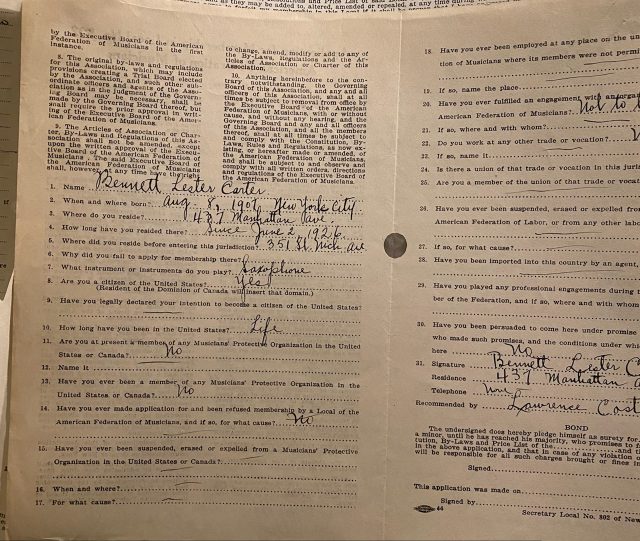
Benny Carter
The vocalist, pianist and songwriter, Una Mae Carlisle, acknowledged as the first African American woman to host her own major radio show—and then television show—was playing Kelly’s Stables on 52nd Street and living in Harlem’s Hotel Theresa when she joined Local 802. This was 1940, when she was fresh from a four-year European residency. Upon arriving in New York, Carlisle led performance and record dates with jazz heavies (802 members, all) including Ray Nance, Zutty Singleton, Benny Carter, Slam Stewart and many others, and then successfully took on the broadcast networks. Tragically, following such victories including overcoming gender and racial barriers, she was diagnosed with terminal cancer, retiring in 1954, and gone two years later. This finding offers us important knowledge of a pioneer who might otherwise become disappeared.
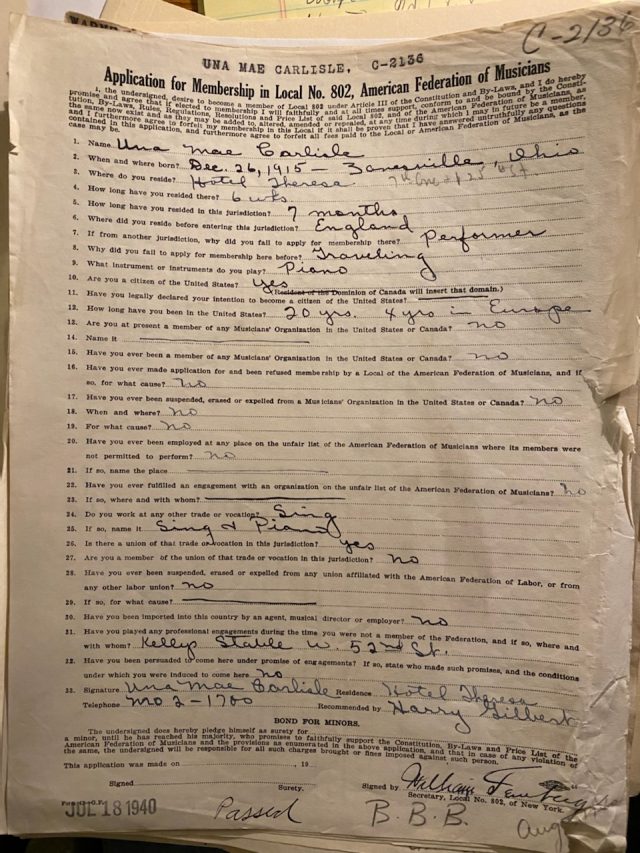
Una Mae Carlisle
Virgil Thomson was not only a celebrated modernist composer, but a deeply learned arts scholar and noted music critic. After decades of travel during which time he collaborated with Gertrude Stein, among others, he moved into the Chelsea Hotel in September of 1940 and applied for regular 802 membership some six months after. He remained a permanent resident of the landmark hotel and Thomson’s output was frighteningly prolific, with hundreds of scores composed for orchestra, ballet, opera, film, chorus, chamber ensemble and solo piano, as well as a dazzling number of “piano portraits” and series of art songs, to his credit. Maybe there’s real magic in that sacred space on 23rd Street, or in the least a thrilling level of inspiration for such driven, talented visionaries.
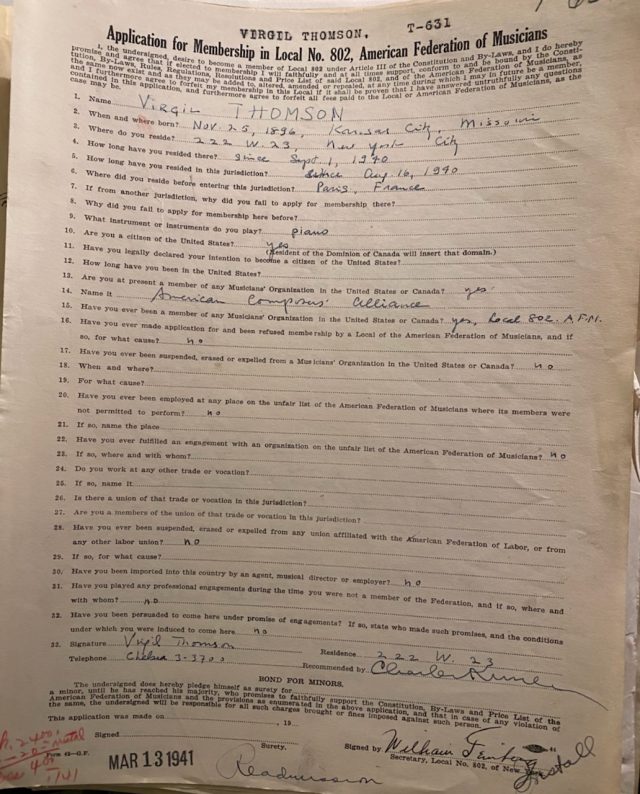
Virgil Thompson
My research also unearthed the 1945 and ‘46 reinstatement applications of pianist/composer/arranger Billy Strayhorn, cemented in our collective memory for his collaboration with Duke Ellington, but the search continues for his initial application (for which Duke Ellington had recommended him for membership). An odd point of interest: the spelling of Strayhorn’s family name on the 1945 document is spelled “Strayhorne,” with all other identifying information accurate. This might indicate that following a tour, blowing back into town with a record date or air-check moments away, someone else in the band completed the paperwork to just get it done. Those remained very busy years for the big bands.
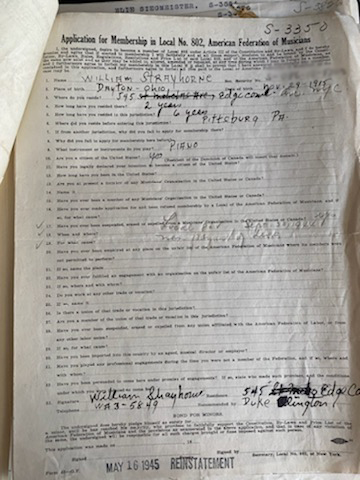
Billy Strayhorn (1945 application, with last name spelled as “Strayhorne”)
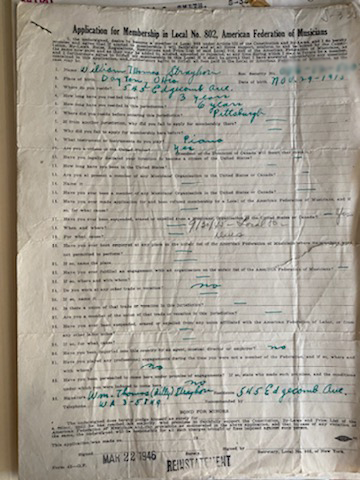
Billy Strayhorn (1946 application, with last name spelled correctly)
Henry Mancini became a Local 802 member in July,1946, following his war-time service and just months after leaving home in Aliquippa, Pennsylvania. The composer who’d go onto global fame for his film and television scores including “Days of Wine and Roses,” “Breakfast at Tiffany’s,” “The Godfather,” “Charade,” “The Molly McGuires,” “Touch of Evil,” “The Pink Panther,” “Peter Gunn,” and “The NBC Mystery Movie” (can you recall that soaring whistle melody?). He joined Local 802 while arranging for the Glenn Miller “ghost band.” Throughout his award-winning career, Mancini’s compositions, tuneful, familiar, hip and complex all at once, touched audiences of screen, stage, radio and concert hall. Mancini later also became a prominent guest conductor, here and abroad.
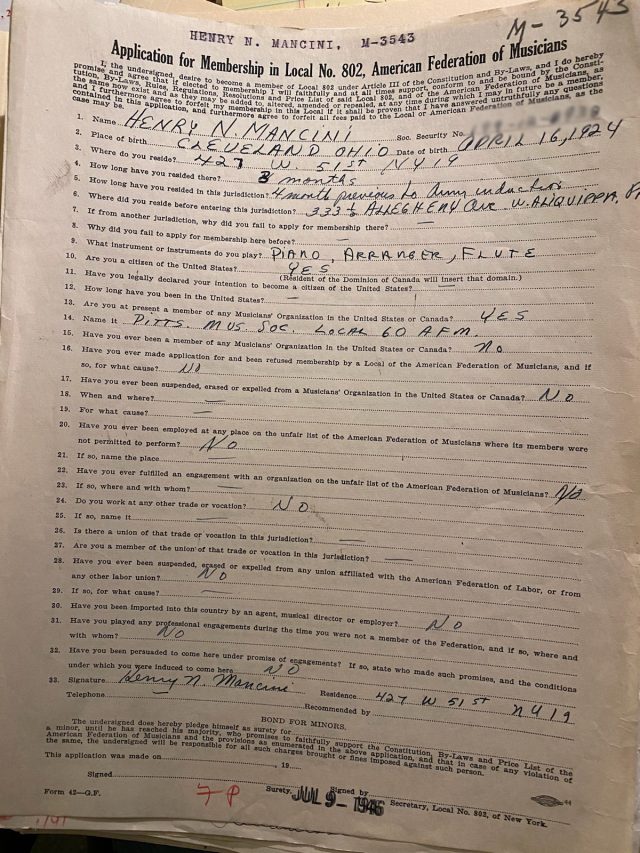
Henry Mancini
Colin McPhee, modernist composer, and a founder of what we now know as world music, moved to Brooklyn in 1938 following a deep musicological expedition to “the Dutch East Indies,” becoming a member a decade later. He stated that his reason for waiting to join 802 was that he’d been employed as a freelance composer, but when asked about his primary instrument, McPhee wrote in “piano” and then crossed it out, hurriedly replacing this with a seeming Balinese instrument (McPhees’ handwriting was only partially legible). And though living uptown by April of ‘48, his application cited a previous address of 7 Middagh Street, the famed February House, where his housemates included W.H. Auden, Benjamin Britten, Paul and Jane Bowles, Richard Wright, Kurt Weill and Lotte Lenya, and Lou Harrison, among other noted artists. The house, until its 1945 demolition, also hosted ongoing performance salons, urgent political discussion and, to say the least, quite spirited parties.
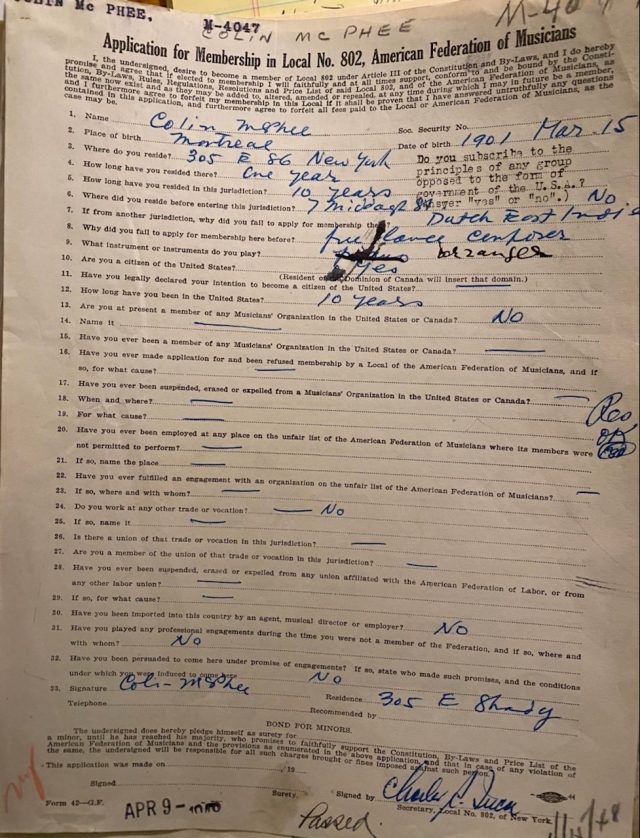
Colin McPhee
In 1948, as the U.S. House Un-American Activities Committee (HUAC) targeted progressives in both the entertainment industry and the labor movement, Local 802 applications added the question, “Do you subscribe to the principles of any group opposed to the form of government of the USA?” This practice continued for several tense years before the local aligned with Actors Equity to fight the Broadway Blacklist HUAC was then crafting. (See https://www.local802afm.org/allegro/articles/broadway-and-the-blacklist/). Among the Local 802 members affected by this red scare attempt to control and whitewash the populace, Leonard Bernstein was hounded by the Committee, experiencing brief period as a blacklistee, but successfully fought back. But Norman Cazden who’d joined 802 in 1934 while teaching at Juilliard, was among the successful New York modern composers linking music to social change. Once under the microscope of the Committee, his career was terribly severed. Even famed big band leader Artie Shaw was subpoenaed to testify by this virulently opportunistic group (the celebrities carried greater and greater media attention for HUAC). What was suspect? His participation, nearly a decade earlier, in both the Hollywood Independent Citizens Committee of the Arts, Sciences and Professions, and the World Peace Congress, warranting hours of grueling questioning. And in 1955 Pete Seeger was subpoenaed and harshly grilled by HUAC, accused of contempt of Congress and sentenced to a year in prison. Though the latter would be overturned, Seeger experienced a total media blacklisting for a dozen years.
The mid-century revolution, as it turned out, was not so much in politics but within jazz. The new wave, known as free jazz, the avant-garde, and the new thing, liberated not only harmony but the role of each instrument and the time-honored tradition of head/solo/head, all the while making a grand statement on racism. Such a conception came to full fruition in ‘59 with Ornette Coleman’s Five-Spot residency, but eight years earlier the visionary pianist Cecil Taylor became a member of our union. On his 1951 application, Taylor cited performances at “school dances” as examples of professional engagements; within six years, he was causing a necessary ruckus at the Newport Jazz Festival. Historian and writer A.B. Spellman wrote of Taylor: “There is only one musician who has, by general agreement even among those who have disliked his music, been able to incorporate all that he wants to take from classical and modern Western composition into his own distinctly individual kind of blues without in the least compromising those blues, and that is Cecil Taylor, a kind of Bartok in reverse.”
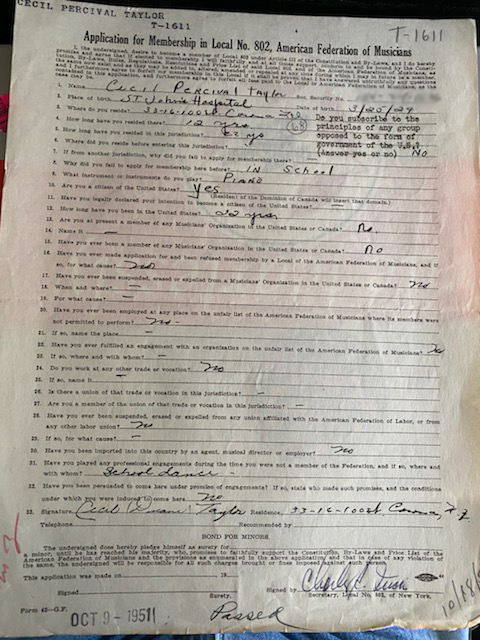
Cecil Taylor
But a year after, Marian McPartland, who hailed from England, relocated from Chicago into our jurisdiction. In 1951 she joined Local 802 as a “Traveling Member” then living on West 88th Street. The pianist who’d met noted Chicago cornet player Jimmy McPartland while both worked for the USO during WW2, performed in his sextet and the two were married by 1945. Post-war, the pair performed together, residing in NYC by ‘49; McPartland signed her first record contact with Savoy, the same year her trio opened at midtown’s Embers steakhouse and nightclub. Within a decade, she began her legendary residence at the Hickory House where her trio included Joe Morello and (802 jazz mover and shaker) Local 802’s own Bill Crow. McPartland’s career remained historic on every level and her editorials in Downbeat included the burning question: “Can’t we women make our own contribution to jazz by playing like women, but still capturing the essential elements of jazz — good beat — good ideas — honesty and true feeling?” McPartland served as a formidable advocate for women in jazz and ventured into the music’s avant garde, her 1960s program on WBAI-FM and later series ‘Piano Jazz’ on NPR ran for decades. She left behind one of the most beloved legacies in the music’s history. McPartland earned many awards in her lifetime including the British high honor of MBE.
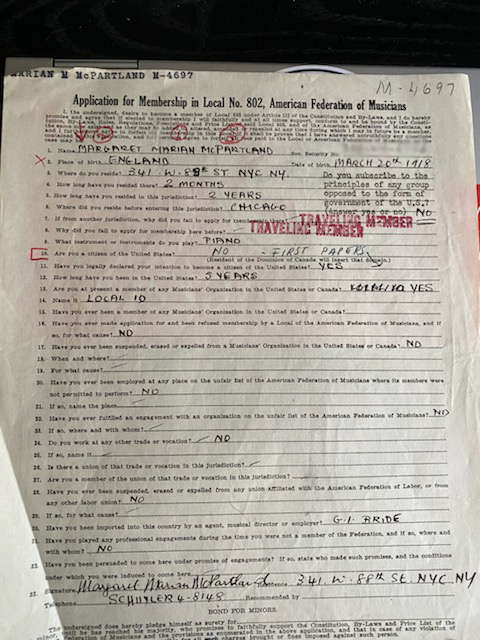
Marian McPartland
Next month, we’ll continue this archeological dig into the illustrious history of Local 802.
You can reach Local 802 Organizing Director John Pietaro at jpietaro@local802afm.org or (212) 245-4802, ext. 230
Chordal Clouds and Whispers: for Ran Blake
by John Pietaro
Bathed in textures of deepest gray,
The soundtrack of sleepless nights and restless days.
Stark. So stark the touch, a distant stare
Through blackest shades.
Ran Blake’s hands shape chordal clouds,
The dark of whispers, mysteries of sound.
So fluid, so wide, a searching dirge of
The bluest hour
Disavowed.
A noir for dreams and tomorrow’s passe’
Naked,
Smoke-filled
Flagrantly apart,
Shadow’s wrath
Tempts midtown souls and
Denizens of old onto
Horizon’s wind, blinding path.
-Composed Sept 2019 following Blake’s performance at Jazz at Kitano. Originally published in the poetry chapbook Smoke Rings by John Pietaro (new Masses Media)
